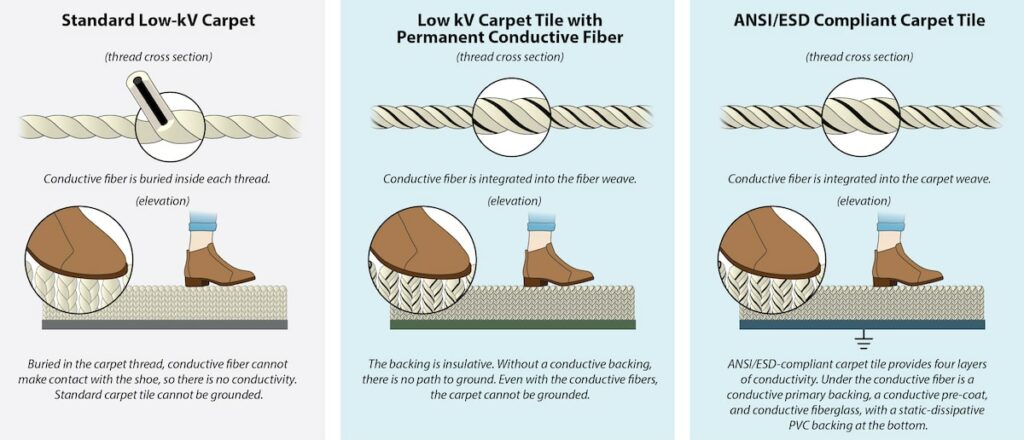Glossary: Antistatic Carpet
The term “antistatic” refers to a condition where an antistatic material inhibits static generation when it comes into frictional contact with another material. In ESD flooring terms, an antistatic floor inhibits static, or prevents some degree of static generation, when people walk on its surface.
Applied specifically to carpet, the term “antistatic” has a slightly different meaning. Antistatic carpet is a generic term and includes all carpet products that generate less static electricity than would be necessary for a person to get a shock after walking on it. Antistatic carpet is not necessarily conductive and cannot be grounded.*
The reason for specifying antistatic carpet is to establish a space that will be free of static shocks, or zaps.

Antistatic carpet usually contains bi-component yarns and may be treated with a topical antistat. Most new antistatic carpet will prevent shocks as long as the relative humidity (RH) is above 25%.
Antistatic carpets do not offer permanent static protection and cannot ground static charges; for these reasons, they cannot protect sensitive electronic components. Antistatic carpet should NOT be confused with conductive or ESD carpet.
* Using conductive adhesive cannot ground this type of carpeting and cannot make it conductive (or static dissipative).
Learning Center Articles
- ESD Basics
- Installation & Maintenance
- Selecting & Specifying an ESD Floor
- Technical Information
- 7 Common Mistakes Selecting an ESD floor
- A Guide to ESD Flooring Selection
- Avoid Costly Failures: What You Need to Know When Specifying ESD Flooring
- Choosing ESD Flooring for:
- ESD Footwear: What Is It and When Is It Necessary?
- ESD Footwear for Electronics Manufacturing and Handling Applications
- Facility Managers’ Guide to Selecting ESD Flooring
- The Need for Due Diligence in Specifying Static-Free Flooring
- Standard of Care for Specifying Floors in Mission-Critical Spaces
- Understanding the Hidden Costs of ESD Flooring

StaticWorx high-performance static-control floors protect electronic components, explosives, and high-speed computers from damage caused by static electricity. ESD flooring is part of a system. Choices should always be based on objective, researched evidence. When you partner with us, we look at all possible items that may need to integrate with the floor, and, focusing on your goals and objectives, help you find the right floor for your application.








